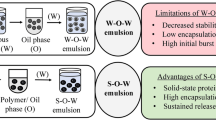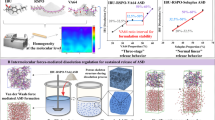Abstract
Purpose
To study the biorelevant drug release from novel starch-based polyvinyl alcohol capsules (S-PVA-C). The effect of the shell material is studied by considering microstructural formulation changes during hydration.
Methods
Two different self-emulsifying systems containing either fenofibrate or probucol were filled in S-PVA-C, as well as capsules of gelatin (SGC) and starch (VegaGels®). Release analysis employed a BioDis® apparatus, while disintegration was studied by texture analysis. For microstructural analysis we used small angle x-ray scattering (SAXS).
Results
S-PVA-C opened only partially in biorelevant media compared to completely opened SGC and VegaGels®. In case of the fenofibrate formulation, this opening mechanism caused only a short lag time, while the probucol formulation in S-PVA-C resulted in a sustained release. The latter formulation demonstrated much higher viscosity upon hydration compared to the fenofibrate system. Such a rheological effect on drug release was barely noted for SGC or VegaGels® and SAXS revealed differences in the hydrated microstructure.
Conclusions
Even though S-PVA-C are highly attractive for encapsulation of rather hydrophilic formulations, some care is needed regarding an immediate release form. The type of formulation hydration must be considered for adequate selection of the capsule material.








Similar content being viewed by others
References
Reich G. Formulation and physical properties of soft capsules. In: Podczeck F, Jones BE, editors. Pharmaceutical capsules. London: Pharmaceutical Press; 2004. p. 201–12.
Misic Z, Muffler K, Sydow G, Kuentz M. Novel starch-based PVA thermoplastic capsules for hydrophilic lipid-based formulations. J Pharm Sci. 2012;101:4516–28.
Lue BM, Nielsen FS, Magnussen T, Schou HM, Kristensen K, Jacobsen LO, et al. Using biorelevant dissolution to obtain IVIVC of solid dosage forms containing a poorly-soluble model compound. Eur J Pharm Biopharm. 2008;69:648–57.
Dressman J, Schamp K, Beltz K, Alsenz J. Characterizing release from lipid-based formulations. In: Hauss DJ, editor. Oral lipid-based formulations: enhancing the bioavailability of poorly water-soluble drugs. New York: Informa Healthcare USA, Inc.; 2007. p. 241–56.
Borst I, Ugwu S, Beckett AH. New and extended applications for USP drug release apparatus 3. Dissolution Technol. 1997;4(1):11–18.
Jantratid E, Janssen N, Chokshi H, Tang K, Dressman JB. Designing biorelevant release tests for lipid formulations: case example - lipid suspension of RZ-50. Eur J Pharm Biopharm. 2008;69:776–85.
Jantratid E, De Maio V, Ronda E, Mattavelli V, Vertzoni M, Dressman JB. Application of biorelevant release tests to the prediction of in vivo performance of diclofenac sodium from an oral modified-release pellet dosage form. Eur J Pharm Sci. 2009;37:434–41.
Porter CJH, Trevaskis NL, Charman WN. Lipids and lipid-based formulations: optimizing the oral delivery of lipophilic drugs. Nature Rev Drug Discov. 2007;6:231–48.
Müllertz A, Ogbonna A, Ren S, Rades T. New perspectives on lipid and surfactant based drug delivery systems for oral delivery of poorly soluble drugs. J Pharm Pharmacol. 2010;62:1622–36.
Lopez-Montilla JC, Herrera-Morales PE, Pandey S, Shah DO. Spontaneous emulsification: mechanisms, physicochemical aspects, modeling and applications. J Dispersion Sci Techn. 2002;23(1–3):219–68.
Wakerly MG, Pouton CW, Meakin BJ. Evaluation of the self-emulsifying performance of a non-ionic surfactant-vegetable oil mixture. J Pharm Pharmacol. 1987;39:6P.
Wakerly MG, Pouton CW, Meakin BJ, Morton FS. The effect of surfactant HLB on the self-emulsifying efficiency of non-ionic surfactant vegetable oil mixtures. J Pharm Pharmacol. 1987;38(S12):2P.
Pouton CW. Formulation of self-emulsifying drug delivery systems. Adv Drug Delivery Rev. 1997;25:47–58.
Regev O, Ezrahi S, Aserin A, Garti N, Wachtel E, Kaler EW, et al. A study of the microstructure of a four-component nonionic microemulsion by cryo-TEM, NMR, SAXS, and SANS. Langmuir. 1996;12(3):668–74.
Biradar SV, Dhumal RS, Paradkar A. Rheological investigation of self-emulsification process: effect of co-surfactant. J Pharm Pharmaceut Sci. 2009;12(2):164–74.
Patil SS, Venugopal E, Bhat S, Mahadik R, Paradkar AR. Probing influence of mesophasic transformation on performance of self-emulsifying system: effect of ion. Mol Pharmaceutics. 2012;9:318–24.
Patil SS, Venugopal E, Bhat S, Mahadik R, Paradkar AR. Microstructural elucidation of self-emulsifying system: effect of chemical structure. Pharm Res. 2012;29(8):2180–8.
Fanun M. Oil type effect on diclofenac solubilization in mixed nonionic surfactants microemulsions. Colloids Surf, A: Physicochem Eng Aspects. 2009;343:75–82.
Teubner M, Strey R. Origin of the scattering peak in microemulsions. J Chem Phys. 1987;87(5):3195–200.
Klein S. Dissolution test methods for modified release dosage forms, Doctoral thesis. Frankfurt am Main: Shaker-Verlag; 2005.
Yu LX, Wang JT, Hussain AS. Evaluation of USP apparatus 3 for dissolution testing of immediate-release products. AAPS Pharm Sci. 2002;4:1–5.
Jantratid E, Janssen N, Reppas C, Dressman JB. Dissolution media simulating conditions in the proximal human gastrointestinal tract: an update. Pharm Res. 2008;25(7):1663–76.
Groves MJ. Rheological characterization of self-emulsifying oil/surfactant systems. Acta Pharm Suecica. 1976;13:353–60.
Pouton CW. Self-emulsifying drug delivery systems: assessment of the efficiency of emulsification. Int J Pharm. 1985;27:335–48.
Rohrs BR, Burch-Clark DL, Witt MJ, Stelzer DJ. USP dissolution apparatus 3 (reciprocating cylinder): instrument parameter effects on drug release from sustained release formulations. J Pharm Sci. 1995;84:922–6.
The United States Pharmacopeia & The National Formulary. The Official Compendia of Standards, USP 35-NF30 2012. Pharmacopoeial Convention Inc., 2012.
Fotaki N, Aivaliotis A, Butler J, Dressman J, Fischbach M, Hempenstall J, et al. A comparative study of different release apparatus in generating in vitro-in vivo correlations for extended release formulations. Eur J Pharm Biopharm. 2009;73:115–20.
Fanun M. Properties of microemulsions based on mixed nonionic surfactants and mixed oils. J Mol Liq. 2009;150:25–32.
Mohsin K, Long MA, Pouton CW. Design of lipid-based formulations for oral administration of poorly water-soluble drugs: precipitation of drug after dispersion of formulations in aqueous solution. J Pharm Sci. 2009;98(10):3582–95.
Cabos C, Delord P, Marignan J. Local lamellar structure in dense microemulsions. Phys Rev B. 1988;37(16):9796–9.
Kogan A, Shalev DE, Raviv U, Aserin A, Garti N. Formation and characterization of ordered bicontinuous microemulsions. J Phys Chem B. 2009;113:10669–78.
ACKNOWLEDGMENTS AND DISCLOSURES
Financial support of the Swiss Caps AG (member of the Aenova group) is gratefully acknowledged.
Author information
Authors and Affiliations
Corresponding author
Rights and permissions
About this article
Cite this article
Misic, Z., Urbani, R., Pfohl, T. et al. Understanding Biorelevant Drug Release from a Novel Thermoplastic Capsule by Considering Microstructural Formulation Changes During Hydration. Pharm Res 31, 194–203 (2014). https://doi.org/10.1007/s11095-013-1152-y
Received:
Accepted:
Published:
Issue Date:
DOI: https://doi.org/10.1007/s11095-013-1152-y




